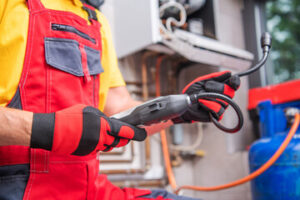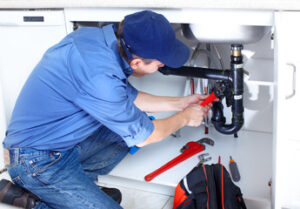Leak detection is a process used to identify and locate leaks of liquids or gases. It is essential to safety measures when dealing with highly pressurized containers or machines.

The longer a leak goes undetected, the worse it gets. A qualified leak detection specialist can help you quickly fix the problem before it worsens. Visit Website to learn more.
A water leak is a common problem for homeowners that can cause a lot of damage in the short term. Whether gushing water from a burst pipe, or simply wet spots around the house that don’t seem to go away, it is important that they are detected and repaired as quickly as possible. This is particularly true if the leak is close to a gas or electricity pipe which could lead to a fire.
Many water leaks are not immediately obvious and are difficult to locate without special equipment. This is because the actual leak opening may be hidden underground or inside walls or other structures. This makes identifying and repairing them challenging. In addition, water pipes often travel underground and can be subject to many types of pressure and temperature changes making them susceptible to movement and cracking.
The good news is that there are a number of ways to detect leaking water. One way is to check the dials on your water meter at off peak times (such as early in the morning) to see if the numbers are going up. This is a clear sign of increased water usage that can be caused by a leak or a burst pipe.
Another way to identify water leaks is by using sonic technology that measures sound waves and can locate the source of the leak. Sonic leak detection devices are designed to pick up on the sound that is created when a liquid escapes from a pipe, usually creating a hissing or whooshing noise. These devices use sophisticated microphones to pick up the sounds and then measure the volume and frequency of the sound to determine the exact location of the leak.
Finally, it is also possible to detect leaks by measuring the difference in pressure on both sides of a pipeline. Leaks are usually found when the pressure on one side of a leak is higher than that on the other. This type of leak detection is commonly used in underground piping where the difference in pressures between both sides of the leak can be significant.
Oil Leaks
Oil leaks aren’t just messy, they can be extremely dangerous for workers and the surrounding environment. Oil can damage equipment and even cause fires when it comes in contact with hot surfaces. The best way to prevent this is by detecting and responding to any oil leaks that occur before they get out of hand.
An oil leak detection system can be used to monitor oil and fuel in data centers, gas stations, and other areas where it might be leaking out of control. It uses a combination of sensors, cables and detectors to continuously monitor oil, fuel and other liquids for any signs of a leak. If an oil leak is detected, it triggers an alarm in the central monitoring system and sends a real-time alert to technicians. The system can be configured to include oil or gas detection sensors, depending on the type of leak and the risk it poses to sensitive environments.
Some oil leaks are small and go unnoticed, while others are more significant and require immediate action. The problem is that oil can easily spread over water or blend in with it, making it difficult for sensors to detect. Getting to the root cause of the leak, such as housing corrosion or worn seals, is crucial.
While there are a few warning signs to watch out for, such as brown greasy spots on your driveway, it can often be hard to tell when an engine oil leak is serious. That’s why it’s so important to make sure that you keep track of the oil level in your car, and check it frequently.
In addition to affecting vehicle performance, engine oil leaks are also a fire hazard and can result in expensive repair bills. If you notice that your car is losing oil at a faster rate than usual, it’s probably time to book an appointment for an oil change. Luckily, these issues can usually be fixed quickly and easily with the right tools and support. With the help of a thermal imaging camera, companies can detect oil and other fluid leaks in the pipeline before they get out of hand and wreak havoc on the surrounding environment. This can protect the integrity of the pipeline, prevent financial loss and minimize environmental impact.
Gas Leaks
Gas leaks pose a serious health and safety threat. If inhaled in high quantities, it can cause asphyxia, or even death in some cases. In order to avoid such dangers, it is necessary to maintain gas appliances and pipes regularly. Additionally, it is important to install carbon monoxide alarms and have a professional inspect the system on a regular basis. Fortunately, there are several ways to detect a gas leak in your home, including an unpleasant sulphur-like smell, whistling noises, visible bubbles and cloudiness around gas lines, and obvious signs of physical damage to gas pipes and appliances.
In addition to the physical signs mentioned above, gas leaks can also be detected using a variety of electronic methods. These include fixed sensors that are placed at high-risk points, such as valves. These can be augmented by vehicle-based systems that roam facilities and pipelines in search of leaks. Finally, portable detectors can be carried by inspection teams to help them locate leaks in hard-to-reach areas.
Regardless of which type of detection technology is used, these methods all help to reduce methane emissions and improve safety for people working at industrial facilities. The data they produce can be integrated into a software application to allow for federal and state reporting, leak grading and the tracking of leak locations for follow-up repair.
If you suspect a gas leak, it is important to evacuate the area immediately and seek emergency medical care if necessary. If you are evacuating your house, be sure to leave your appliances turned off and do not re-enter until a professional has deemed it safe to do so. It is also a good idea to stay away from light switches, telephones and cell phones in the affected area, as they could create a spark that ignites the gas. Additionally, if you plan to dig in your yard, remember to call 811 before starting any digging projects. This free service will provide you with information about any underground utility lines in your area, including natural gas pipelines. Doing so can save you a lot of trouble and potential injury.
Electrical Leaks
Electrical leaks are a real concern that can lead to dangerous fire hazards. They can be caused by faulty wiring or equipment that is no longer in good condition. It is also possible for leakage to occur through defective insulators in devices like capacitors, semiconductors, and transistors. If this happens, the device will start to discharge or leak current into the environment, resulting in a voltage discharge that can cause an electric shock if someone touches exposed metal parts.
A variety of methods can be used to detect electrical leaks. One common method involves using an acoustic detection technique. This works by recording sound waves that are produced by the leaking substance and sending them to a safety control center where it can be identified and mapped. Another method involves using a chemical analysis of the substance that is leaking. A computer then uses this information to create a visual representation of the chemical spill or leak, making it easier for emergency personnel to locate and address the issue.
Lastly, it is possible to use an infrared scanner to detect electrical leaks. This technique is based on the fact that some gases, such as hydrogen, fluorine, and radioisotopes, absorb infrared radiation. These chemicals then reflect infrared light that is emitted by the surface of the leaking material. By measuring the amount of infrared radiation that is reflected by a given area, it is possible to calculate how much of the gas is present.
Many people can avoid electrical leaks by implementing a few simple precautions. This can include installing GFCI outlets in areas of the home that may be exposed to water, such as kitchens and bathrooms. It is also important to check regularly for any signs of leakage, such as discoloration or scorch marks on appliances or outlets.
Finally, it is always a good idea to have a voltage tester handy to conduct routine checks of the electrical system in your home. If you notice that your electricity meter is spinning faster than usual, it may be a sign of a leak. Additionally, if you notice any signs of arcing or sparking in your home, it is important to contact a professional to resolve the problem immediately.


